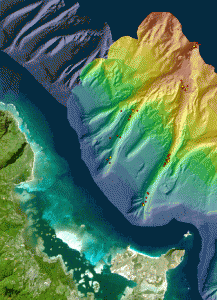By Alton Parrish.
Researchers sampled diversity in Hawaii’s submarine canyons, including these off Kaneohe Bay

Credit: University of Hawai‘i at Mānoa.
The scientists evaluated and mapped landscape metrics of each canyon habitat, including the roughness of the seafloor and the steepness of canyon walls. At depths of 350, 650, and 1,000 meters in each location, they collected sediment core samples on the canyon floor. From these samples, they carefully sorted out and identified all of the marine organisms called macrobenthos—including worms, clams and shrimp-like crutaceans— that range in size from a millimeter to several centimeters. The scientists then correlated the macrobenthos species data with the landscape metrics.

One thing that became evident from this study was that canyons near the main Hawaiian islands tended to collect and hold much more land-based organic matter than canyons in the Northwestern Hawaiian Islands. Materials such as branches, leaves, nuts and algae were abundant off Moloka‘i and O‘ahu, washed into the ocean by rain and carried out deep onto the canyon floors by ocean currents. These decomposing materials, scarcer in the islands of Nihoa and Maro Reef, serve as valuable food sources for the seafloor invertebrates, themselves a food source for other, larger fish.
The scientists have already documented four new species discovered during the course of their research dives, including three new types of crustaceans. Up to 60 percent of the species that taxonomists identified in the submarine canyon seafloor samples are only recognized to the family level.
“There is room for discovery of many more new species,” De Leo said. “The deep sea fauna of Hawai‘i is poorly sampled and poorly understood. Every time we go to sea and sample a new area, it’s likely that we’ll find a new species.”
This series of dives was conducted on the Pisces IV and Pisces V manned submersibles operated by the Hawai‘i Undersea Research Laboratory (HURL). The research was conducted in partnership with Hawai‘i Pacific University and the New Zealand National Institute of Water and Atmospheric Research.
Citation: Fabio C. De Leo, E.W. Vetter, C. R. Smith, A. R. Ashley, and M. McGranaghan. Spatial scale-dependent habitat heterogeneity influences submarine canyon macrofaunal abundance and diversity off the Main and Northwest Hawaiian Islands. Deep Sea Research Part II: Topical Studies in Oceanography. 11 July 2013.


